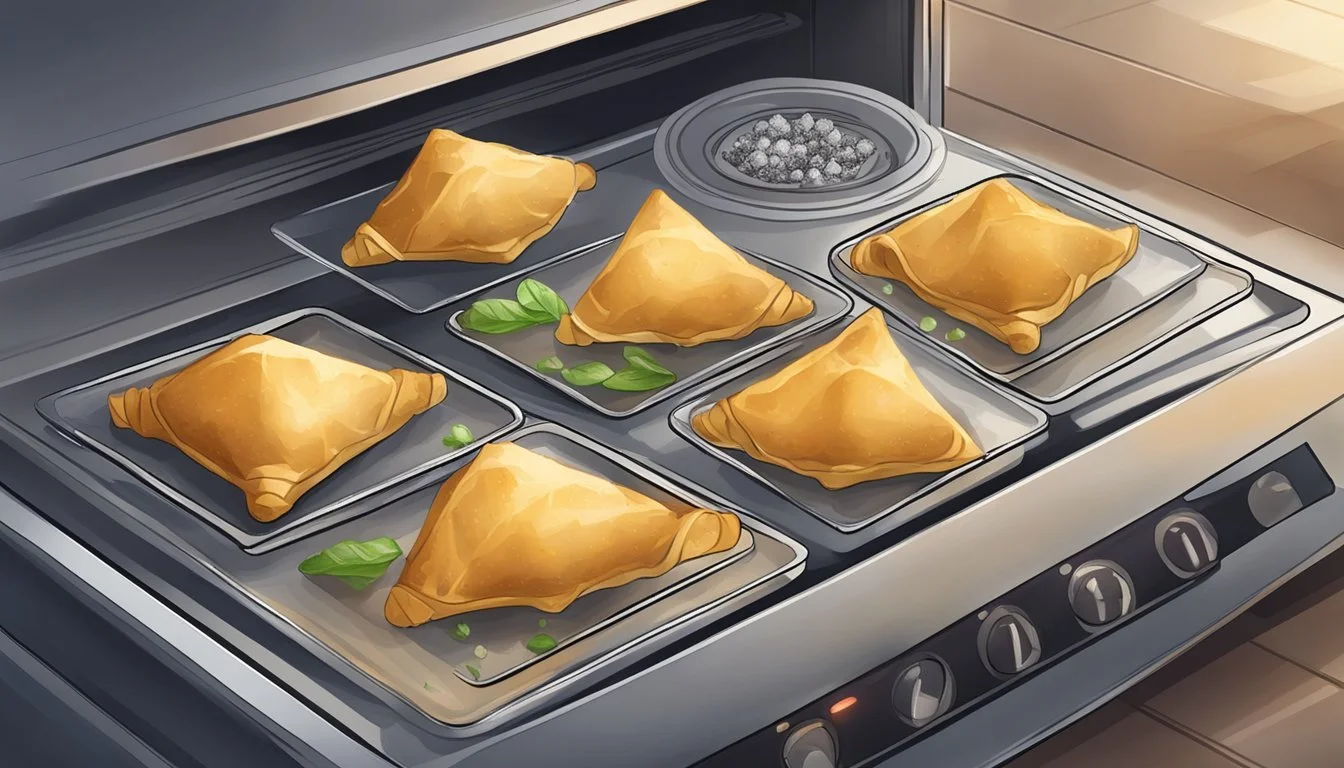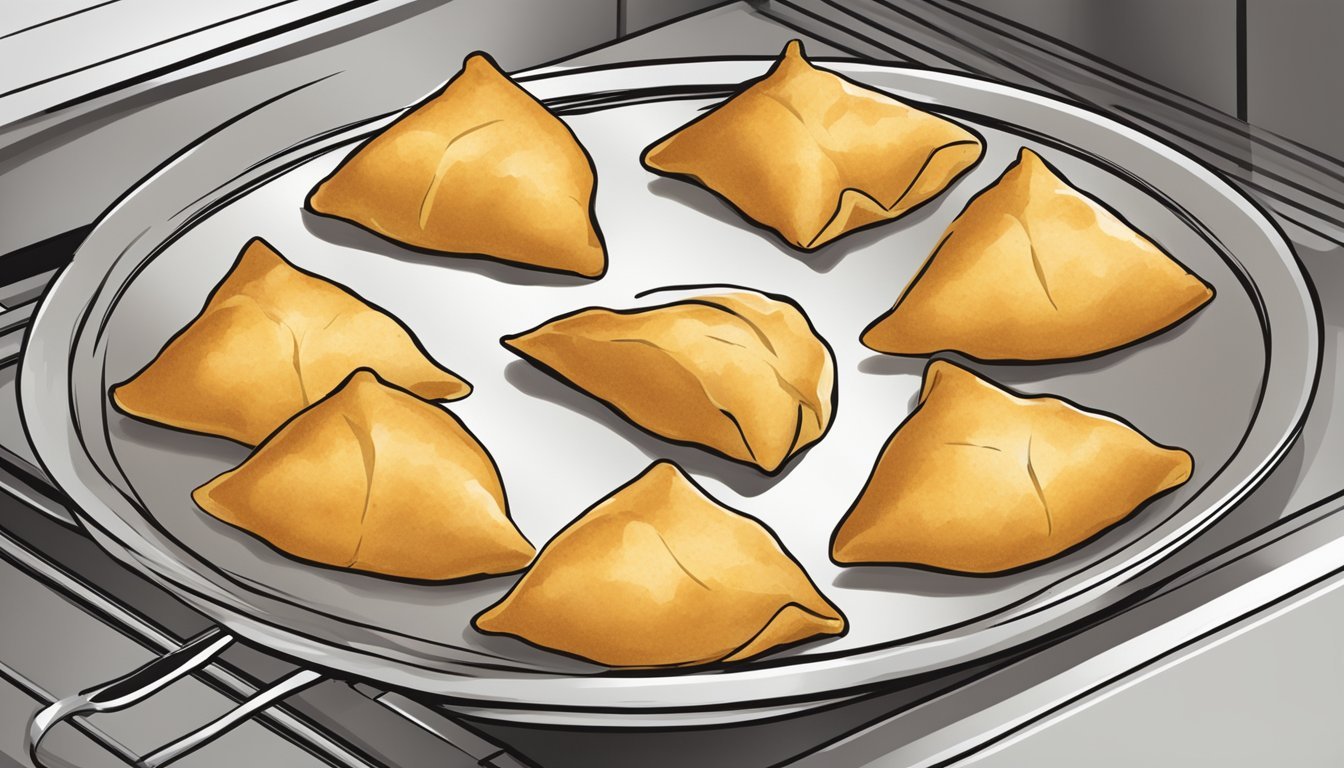How to Reheat Gluten-Free Samosas for Optimal Taste and Texture
Gluten-free samosas are a delightful treat, but enjoying them fresh and crispy can be a challenge if not properly reheated. The best way to reheat gluten-free samosas is in the oven. Preheat your oven to 375°F (200°C). Place the samosas on a wire rack to ensure even heating and bake for 15-20 minutes until they are warm all the way through. This method prevents them from becoming soggy and maintains their crisp texture.
Additionally, if you're feeling adventurous, you can also try reheating your samosas in an air fryer. Set it to 350°F and heat them for about 10 minutes. This will give the samosas a quick and efficient reheating process, keeping them crispy without overcooking.
For those who need a quicker option, the microwave can be used, but be aware that it might result in a softer crust. To mitigate this, place a paper towel under the samosas to absorb some moisture. Knowing these methods can ensure your gluten-free samosas remain as delicious as when they were first made.
Understanding Gluten-Free Samosas
Gluten-free samosas offer a delicious twist on a traditional dish, using specialized dough and a variety of savory fillings to cater to gluten-sensitive individuals. The key elements involve choosing the right ingredients and understanding their preparation.
Defining Gluten-Free
Gluten-free refers to foods made without gluten—a protein found in wheat, barley, and rye. This is essential for people with celiac disease or gluten sensitivity. Gluten-free samosas substitute standard wheat flour with alternatives like rice flour, chickpea flour, or gluten-free all-purpose flour. This ensures the dish remains safe for those avoiding gluten.
The Ingredients for Gluten-Free Dough
Creating a proper gluten-free dough is crucial. The main ingredients often include:
Gluten-free all-purpose flour
Salt
Vegetable oil or ghee
Water
The right balance of these components ensures the dough is pliable yet firm. Mix the flour and salt first. Then, incorporate the oil before gradually adding water. Kneading is essential to achieve a smooth texture. Letting the dough rest under a damp cloth helps it become more elastic and manageable.
Choosing the Right Filling
A great samosa filling combines potatoes, peas, and various spices. Traditional flavors can be maintained using:
Cooked and mashed potatoes
Boiled peas
Chopped onions
Ginger-garlic paste
Cumin seeds
Turmeric, coriander, garam masala
Heat oil in a pan. Sauté onions until they are transparent. Add ginger-garlic paste and spices. Then mix in the potatoes and peas. This combination creates a flavorful and satisfying filling for your gluten-free samosas.
This understanding ensures that anyone can enjoy gluten-free samosas without compromising on taste or texture. The right ingredients and careful preparation techniques make it possible to create a dish that is both safe and delicious.
Preparing for Reheating
When reheating gluten-free samosas, ensure they maintain their crispiness and avoid sogginess. Follow specific steps to thaw frozen samosas and consider pre-reheating tips for optimal results.
Thawing Frozen Samosas
Frozen samosas should be thawed properly before reheating. Place them in the refrigerator for several hours or overnight. This gradual thawing process ensures the filling remains intact. If time is limited, defrost them in a microwave on a low setting for 1-2 minutes, but avoid using high heat to prevent them from becoming soggy.
Remove any excess moisture with a paper towel after thawing. This step is crucial to achieving a crispy texture during reheating. Make sure to handle them gently to prevent the delicate gluten-free crust from breaking.
Pre-Reheating Tips
Preheat your oven to 350°F (175°C) for a consistent reheating method. Set the samosas on a baking tray lined with parchment paper to avoid sticking. A wire rack can also be used to allow air circulation, enhancing crispiness.
If reheating on a stovetop, heat a small amount of olive oil in a pan over medium heat. Cook each side for 3-4 minutes until golden brown. This method is effective for adding extra crunch. Frozen peas can be served alongside the samosas for a complete gluten-free meal.
Avoid overcrowding the pan or tray to ensure even heating. Whether using an oven or stovetop, always check the internal temperature to confirm it's heated all the way through.
Reheating Techniques
Reheating gluten-free samosas can be done in several ways to ensure they remain crispy and delicious. The followings are effective techniques for reheating while maintaining their texture and flavor.
Oven Reheating Method
Preheat the oven to 350°F (180°C). Arrange gluten-free samosas on a baking sheet lined with parchment paper. Place the baking sheet in the oven and reheat for 10-15 minutes or until the samosas are crispy and golden brown.
For frozen samosas, increase the reheating time to 15-20 minutes. To check if they are heated thoroughly, insert a fork into the center. If the filling is hot, they are ready to serve.
Stovetop Reheating Method
Heat a non-stick pan or skillet over medium heat. Add a small amount of oil to the pan. Place the gluten-free samosas in the pan, ensuring they do not overlap. Reheat for about 2-3 minutes on each side until the exterior is crispy and the filling warm.
Flip them carefully to avoid breaking. This method provides a crispy texture but requires attention to prevent burning.
Air Fryer Reheating Method
Set the air fryer to 350°F (180°C). Place the samosas in the air fryer basket in a single layer. Cook for 5-7 minutes, shaking the basket halfway through to ensure even heating.
This method results in a crispy exterior similar to oven reheating. Check the filling by using a fork to ensure it is hot throughout before serving.
Microwave Reheating Method
Place the samosas on a microwave-safe plate. Heat them at medium power (50% intensity) for 30 seconds. Flip each samosa using tongs or a fork and continue microwaving in 20-second bursts until heated thoroughly.
While quick, this method might make the samosas slightly soggy. To improve crispiness, finish them in a preheated oven or toaster oven for 3-5 minutes.
Ensuring Optimal Texture and Flavor
To maintain the texture and flavor of gluten-free samosas, careful attention must be given to oil selection and seasoning retention during reheating.
Oil Selection for Crispiness
Choosing the right oil is crucial to achieving the desired crispiness in reheated gluten-free samosas. Light oils such as sunflower, canola, or vegetable oil are recommended because they do not overpower the spices and flavor. Olive oil can also be used but should be applied sparingly to avoid altering the samosas' taste.
When reheating on the stovetop, lightly coat the surface of a non-stick pan with oil. This helps in evenly heating and crisping the outer layer while preventing sticking. For oven reheating, brushing a thin layer of oil on the samosas before placing them in the oven can enhance their crunchiness.
Avoid using too much oil as it can make the samosas greasy and detract from their natural flavors. Proper oil selection and application work together to ensure samosas remain crispy and delicious.
Spices and Seasoning Retention
Maintaining the original spices and seasoning is essential for flavor integrity when reheating. Gluten-free samosas are often seasoned with a mix of cumin, coriander, turmeric, and garam masala.
To preserve these flavors, it's advisable to use methods that do not expose the samosas to excessive moisture. Oven reheating at 350°F (180°C) for 10-15 minutes or until hot can help keep spices intact. Wrapping samosas in foil before placing them in the oven prevents drying out while still retaining the inherent spices.
Adding a small pinch of fresh spices after reheating can also rejuvenate the samosas' flavor profile. This method ensures each bite is as flavorful as when first made. Proper handling of spices during reheating makes gluten-free samosas both crispy and bursting with flavor.
Serving and Pairing
When serving gluten-free samosas, it is essential to consider both the accompanying dips and chutneys, as well as complementary side dishes, to enhance the overall experience.
Dips and Chutneys
Tamarind chutney offers a sweet and tangy flavor profile that pairs wonderfully with the savory filling of gluten-free samosas.
Cilantro chutney, with its fresh and herbal notes, provides a well-balanced contrast to the spiciness of the samosas.
Raita, a yogurt-based dip with cucumbers and a hint of lemon juice, cools down the palate and complements the crispy texture of the samosas.
A mix of these dips allows for a versatile and enjoyable tasting experience.
Complementary Side Dishes
Chana masala, a spicy chickpea stew, adds a hearty component to the meal without overpowering the samosas.
A light salad, featuring ingredients like cucumbers, tomatoes, and fresh cilantro, offers a refreshing counterpoint and keeps the focus on the samosas.
Basmati rice, subtly flavored with cumin or lemon juice, can serve as a mild backdrop that lets the samosas shine.
Pickled vegetables provide a tangy crunch that contrasts nicely with the soft interior and crispy exterior of the samosas.
These sides not only complement the main dish but also help create a well-rounded meal suitable for various occasions, whether as an appetizer or main course.
Nutritional Considerations
When preparing gluten-free samosas, understanding their nutritional profile and how to incorporate them into your diet is crucial. This can ensure you enjoy these tasty treats without compromising your health goals.
Caloric and Macronutrient Breakdown
A standard gluten-free samosa typically contains between 150-200 calories. The macronutrient composition can vary, but here’s a general idea:
Protein: 3-5 grams
Fat: 8-12 grams
Carbohydrates: 15-25 grams
Fiber: 1-3 grams
The type of flour used can impact the nutritional values. For example, rice flour may have different carb content compared to almond flour. The filling also plays a key role – a vegetable filling will have different macronutrient values than a meat or lentil-based filling.
Incorporating Samosas into a Balanced Diet
To include gluten-free samosas in a balanced diet, consider the following tips:
Pairing: Pair samosas with a protein-rich side, such as grilled chicken or tofu, to balance the macronutrient profile.
Portion Control: Stick to 1-2 samosas per meal to keep calorie intake in check.
Meal Planning: Integrate samosas into meals rich in vegetables and low in simple carbohydrates to maintain nutritional balance.
Healthy Substitutes: Use healthier cooking methods such as baking or air-frying instead of deep-frying to reduce fat content.
These practices help maintain nutritional balance and allow you to enjoy gluten-free samosas as part of a healthy diet.
Special Dietary Considerations
When reheating gluten-free samosas, it's crucial to consider various dietary restrictions like vegan and nut-free options. Careful attention ensures that the needs of a diverse group of individuals are met.
Vegan Varieties
Vegan gluten-free samosas should be free from animal products, such as meat, dairy, eggs, and honey. Common vegan fillings include spiced potatoes, peas, onions, and lentils. Ensure that the pastry is also vegan by using alternatives like rice flour or chickpea flour, which provide a similar texture to traditional wheat-based pastries.
When reheating, use methods like baking or air frying to maintain the crispiness without adding extra fats. Avoid using butter or ghee, opting instead for plant-based oils like coconut or olive oil. Double-check the labels of all pre-made ingredients to ensure they comply with vegan standards.
Nut-Free Options
For those with nut allergies, selecting ingredients and cooking methods that are nut-free is vital. Samosa recipes can include various safe options like potatoes, carrots, peas, and other vegetables. Be cautious with spices and pre-made mixes, as cross-contamination can occur in manufacturing processes.
Reheating nut-free samosas can follow the same procedures as other types: use a non-stick pan or oven, and avoid nut-based oils like peanut or almond oil. Stick to safe, generic brands that are certified nut-free to prevent allergic reactions. Always read ingredient labels carefully and consider making samosas from scratch to have full control over the contents.
Recipe Adaptations and Substitutions
When preparing gluten-free samosas, selecting the right ingredients and making thoughtful adjustments is crucial for catering to various dietary needs and preferences. Below are key considerations for making effective adaptations and substitutions.
Alternative Flours and Binders
For a gluten-free dough, using a mix of gluten-free all-purpose flour along with additional binders like xanthan gum is often effective. Almond flour and tapioca flour can be used as substitutes but will alter the texture. Almond flour adds a slightly nutty flavor, while tapioca flour can increase elasticity.
Xanthan gum acts as a binder, providing the dough with necessary pliability. Arrowroot flour can replace xanthan gum in equal measure if preferred. Here’s a basic flour mix:
1 cup gluten-free all-purpose flour
1/4 cup almond flour
1/4 teaspoon xanthan gum
These substitutions ensure a flexible, yet flavorful dough, suitable for various dietary needs.
Adjusting Spices for Dietary Restrictions
Adjusting the spice levels or types is necessary for those with dietary restrictions. Traditional samosa spices like cilantro, cumin, and turmeric can be modified. Those allergic to cilantro can use parsley as a substitute. If reducing heat, remove or decrease the amount of chili powder and use milder paprika.
For those avoiding garlic or onions, omitting them will change the flavor profile but can be compensated by using other spices like fennel seeds or asafoetida in moderation. Always check for cross-contamination labels on spices to ensure they align with gluten-free standards.
By making these careful adjustments, a versatile and enjoyable dish for all palates is achievable.
Storage and Food Safety
Proper storage of gluten-free samosas is essential for maintaining their taste and ensuring food safety.
Storage
Refrigeration: Store leftover samosas in an airtight container. Keep them in the refrigerator, where they can last for up to 3 days.
Freezing: For longer storage, freeze the samosas. Place them in a single layer on a baking sheet to freeze individually. Then, transfer to a freezer-safe bag. They can be stored for up to 2 months.
Reheating Tips
Oven: Preheat the oven to 350°F (175°C). Place the samosas on a baking sheet lined with parchment paper. Heat for 10-15 minutes to ensure they are hot throughout.
Microwave: Use a microwave for a quick reheat, but this may make the samosas soggy. Reheat for 1-2 minutes on medium power.
Food Safety Considerations
Temperature Control: Ensure samosas are either kept hot at 140°F (60°C) or cold at 40°F (4°C) to prevent bacterial growth.
Handling: Wash hands before handling cooked samosas and use clean utensils to avoid cross-contamination.
Discard Policy: If samosas have been left out at room temperature for more than 2 hours, discard them to avoid risk of foodborne illness.






